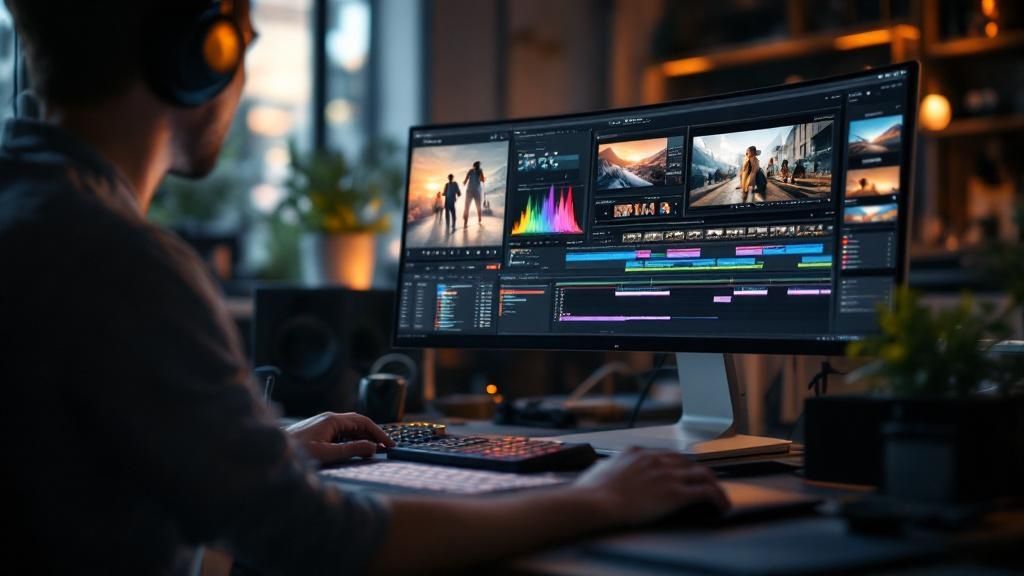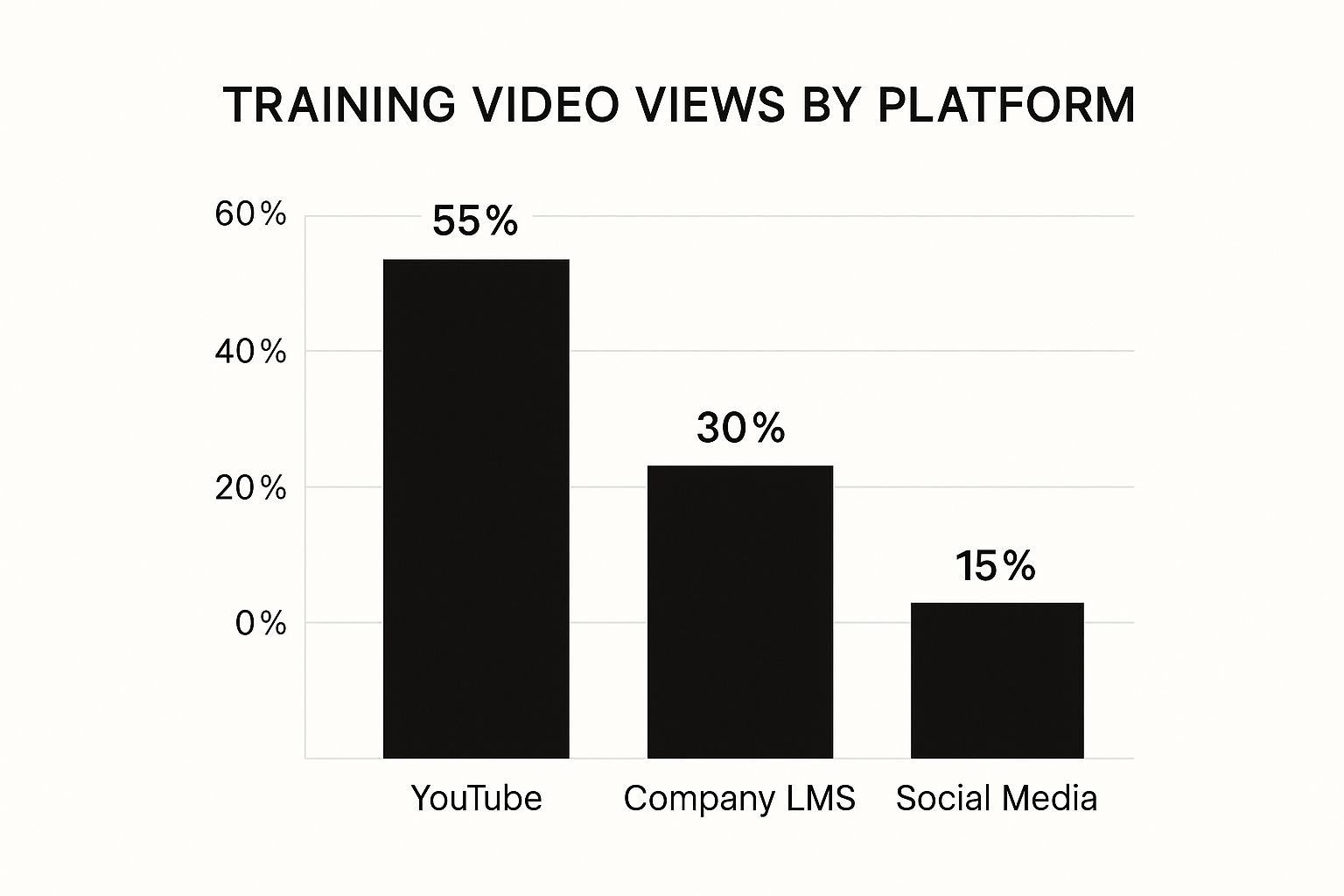How to Create Training Videos That Engage and Educate Your Team

Learn how to create training videos that captivate and educate. Our complete guide covers planning, recording, and editing to make effective training content.
Introduction
Knowing how to create training videos is an essential skill for modern organizations looking to scale their knowledge and onboard teams effectively. This guide will walk you through the entire process, from planning and scripting to recording and editing, ensuring you create content that is clear, engaging, and impactful for your learners.
Why This Topic Matters
Traditional training methods, like dense manuals and long-winded presentations, are often ineffective and fail to hold attention. Video training solves this by catering to multiple learning styles—visual learners see the process, while auditory learners absorb the narration. This multi-sensory approach dramatically improves knowledge retention.
Furthermore, video training provides a strategic advantage. It allows you to scale high-quality, standardized instruction across your entire organization, ensuring every employee receives the same consistent message. This is crucial for maintaining quality, compliance, and building a culture of continuous learning. The corporate training market is projected to reach $487 billion by 2030, a testament to video's proven effectiveness.
Step-by-Step Guide: How to Create Training Videos
Step 1: Planning and Pre-Production
A great training video starts long before you ever hit record. Rushing into a recording without a solid plan is the number one reason training content fails. This pre-production phase is your blueprint for a video that is clear, purposeful, and effective.

- Define Your Learning Objectives and Audience: First, answer two critical questions: "What should the viewer be able to do after watching?" and "Who is my viewer, and what do they already know?" A specific, action-oriented objective (e.g., "Demonstrate how to create a new customer invoice") is far better than a vague one.
- Choose the Right Video Format: Your format should match your message.
- Screen Recordings: Ideal for software tutorials and process walkthroughs.
- Direct-to-Camera: Best for building a personal connection, such as in company announcements or conceptual lessons.
- Animated Explainer Videos: Great for breaking down complex or abstract ideas into simple visuals.
- Hybrid Approach: Combining a screen recording with a webcam view of the presenter is often the most effective method.
- Script and Storyboard Your Content: A script, even a simple bullet-point outline, keeps you on track and prevents rambling. A storyboard is a visual map of your video, helping you plan shots and visual aids before you record, which saves massive time during editing.
Step 2: Recording Your Video and Audio
You don't need a Hollywood budget, but you do need the right techniques to capture clean video and crisp audio. Getting these fundamentals right during recording will save you hours of frustrating work in post-production.

- Set Up for Clear Audio: Bad audio is a deal-breaker. Record in a quiet space, away from background noise like fans or traffic. Use a dedicated USB or lavalier microphone—the built-in mic on your laptop is not good enough.
- Record Your Screen Effectively: If you're demonstrating something on-screen, eliminate clutter by closing unnecessary tabs and hiding desktop icons. Use a tool like ShotVu to record. Move your mouse cursor smoothly and deliberately. Record in smaller, manageable chunks; it's easier to re-record a short segment than a long, single take. For more tips, check our guide on how to record YouTube videos.
Step 3: Editing and Post-Production
The editing room is where you shape your raw footage into a polished, professional training video. This is what separates amateur content from one that genuinely educates.

- Trim and Assemble: Your first pass is cleanup. Cut out all the "ums," "ahs," long pauses, and mistakes. Assemble your best takes into a logical sequence that follows your script.
- Add Visual Enhancements: Use visual aids to guide the viewer’s attention.
- Text Overlays: Introduce new topics or highlight key terms.
- Callouts and Arrows: Point directly to important on-screen elements.
- Zoom and Pan: Bring focus to specific parts of the screen.
- Polish Your Audio: Ensure your narration is clear and at a consistent volume. If you add background music, keep its volume low (5-10% of the narration's volume). Use a noise reduction filter if available. Our guide on how to edit a screen recording on Mac has more platform-specific tips.
- Add Final Touches: Include a branded intro and outro to create a cohesive, professional experience. Watch the final video from start to finish to catch any last-minute errors.
Tips, Best Practices, and Common Mistakes
- Pace Yourself: Speak slightly slower than you would in a normal conversation to ensure clarity and project confidence.
- Vary Your Vocal Tone: A monotone delivery is boring. Emphasize key words and let your enthusiasm come through. Smiling while you speak can improve your tone.
- Don't Overdo Effects: Keep graphics and transitions clean and simple. They should support the content, not distract from it.
- Avoid the "One-Take" Trap: Record in short, manageable sections. It’s far less stressful and results in a better final product.
- Stand Up While Recording: This simple trick opens up your diaphragm, helping you project your voice and adding energy to your delivery. We have more professional presentation recording tips on the ShotVu blog.
Examples: Production Styles and Costs
Choosing a production style depends on your goals and budget. A simple screen recording may be perfect for an informal how-to, while formal compliance training may require a more polished approach.

Here’s a look at common video types and their estimated costs per finished minute.
| Video Type | Estimated Cost per Minute | Best For | | :--- | :--- | :--- | | Simple Screen Recording | $0–$50 | Informal how-tos, bug reports, quick walkthroughs. | | Narrated Presentation | $50–$250 | Conceptual training, policy updates, onboarding. | | "Talking Head" Video | $60–$1,500+ | Leadership messages, expert interviews, soft skills. | | Animated Video | $300–$2,000+ | Explaining complex or abstract topics simply. | | Interactive Video | $900–$2,700+ | Immersive learning, compliance, skill assessments. |
A bigger budget doesn't guarantee better training. A clear screen recording that solves a specific problem is more valuable than a slick video that misses the point.
FAQ: How to Create Training Videos
Here are answers to some of the most common questions about creating training videos.
How long should a training video be? Shorter is almost always better. Aim for 3-7 minutes to align with modern attention spans and the principles of microlearning. If a topic is complex, break it into a series of shorter videos instead of one long one. This makes the content more digestible and easier for viewers to revisit.
What is the single most important part of a training video? Clear audio is non-negotiable. Viewers will tolerate imperfect video quality, but they will not watch a video if they can't understand the narration. Muffled, echoey, or noisy audio makes your content unusable. Invest in an external microphone and a quiet recording space—it’s the most important step for creating professional-quality videos.
How much does it really cost to make a training video? The cost varies widely. A DIY screen recording can be virtually free, costing only your time. Professionally produced videos typically range from $400 to $2,000 per finished minute, with an average around $1,200 per minute. For a deeper dive, check out this in-depth pricing analysis.
What are simple ways to make my videos more engaging? To boost engagement, start with a strong hook that states the video's value. Speak with an energetic, conversational tone. Use visual aids like callouts and zooms to guide the viewer's focus. Mix up your visuals by cutting between screen recordings, graphics, or on-camera footage. Our guide on how to record a presentation with audio has more tips.
What tools do I need to start creating training videos? To start, you need three basic things:
- A good microphone: A USB or lavalier mic is a must for clear audio.
- Screen recording software: A tool like ShotVu lets you capture your screen, webcam, and audio simultaneously.
- Video editing software: Many screen recorders have built-in editors for trimming clips, adding text, and exporting the final video.
Conclusion / Summary
Creating effective training videos is a straightforward process when you follow a structured approach. The key takeaways are:
- Plan First: Define your objectives, audience, and script before you record.
- Prioritize Audio: Clear sound is more critical than perfect video.
- Keep it Concise: Break down complex topics into short, focused videos (3-7 minutes).
- Edit for Clarity: Use simple visual aids and a clean edit to enhance learning.
By following these steps, you can move beyond boring manuals and create a library of engaging video content that empowers your team, improves skills, and boosts productivity.
Call-to-Action
Ready to move past endless meetings and create training content that actually works? With ShotVu, you can record your screen, webcam, and audio with a single click, edit with ease, and share polished videos instantly. Start creating clear, engaging training videos today.
Discover how ShotVu can transform your team's communication
{
"@context": "https://schema.org",
"@type": "Article",
"mainEntityOfPage": {
"@type": "WebPage",
"@id": "https://shotvu.com/create-training-videos"
},
"headline": "How to Create Training Videos That Engage and Educate Your Team",
"image": "https://cdn.outrank.so/338f308b-87cf-414f-ac8a-cd140ee9b216/b5c65ce8-f47d-49b3-8fb9-97da0ccd7899.jpg",
"author": {
"@type": "Organization",
"name": "ShotVu",
"url": "https://shotvu.com"
},
"publisher": {
"@type": "Organization",
"name": "ShotVu",
"logo": {
"@type": "ImageObject",
"url": "https://shotvu.com/logo.png"
}
},
"datePublished": "2023-10-26",
"dateModified": "2023-10-26",
"description": "Learn how to create training videos that engage and educate your team. This step-by-step guide covers everything from planning and recording to editing and distribution.",
"articleBody": "This guide provides a comprehensive walkthrough on how to create effective training videos. It covers planning, scripting, choosing formats, recording audio and video, editing, and best practices for engaging your audience."
}
{
"@context": "https://schema.org",
"@type": "FAQPage",
"mainEntity": [
{
"@type": "Question",
"name": "How long should a training video be?",
"acceptedAnswer": {
"@type": "Answer",
"text": "Shorter is almost always better. Aim for 3-7 minutes to align with modern attention spans and the principles of microlearning. If a topic is complex, break it into a series of shorter videos instead of one long one. This makes the content more digestible and easier for viewers to revisit."
}
},
{
"@type": "Question",
"name": "What is the single most important part of a training video?",
"acceptedAnswer": {
"@type": "Answer",
"text": "Clear audio is non-negotiable. Viewers will tolerate imperfect video quality, but they will not watch a video if they can't understand the narration. Muffled, echoey, or noisy audio makes your content unusable. Invest in an external microphone and a quiet recording space—it’s the most important step for creating professional-quality videos."
}
},
{
"@type": "Question",
"name": "How much does it really cost to make a training video?",
"acceptedAnswer": {
"@type": "Answer",
"text": "The cost varies widely. A DIY screen recording can be virtually free, costing only your time. Professionally produced videos typically range from $400 to $2,000 per finished minute, with an average around $1,200 per minute. For a deeper dive, check out this in-depth pricing analysis."
}
},
{
"@type": "Question",
"name": "What are simple ways to make my videos more engaging?",
"acceptedAnswer": {
"@type": "Answer",
"text": "To boost engagement, start with a strong hook that states the video's value. Speak with an energetic, conversational tone. Use visual aids like callouts and zooms to guide the viewer's focus. Mix up your visuals by cutting between screen recordings, graphics, or on-camera footage."
}
},
{
"@type": "Question",
"name": "What tools do I need to start creating training videos?",
"acceptedAnswer": {
"@type": "Answer",
"text": "To start, you need three basic things: 1. A good microphone. 2. Screen recording software like ShotVu. 3. Video editing software, which is often built into screen recorders."
}
}
]
}
{
"@context": "https://schema.org",
"@type": "HowTo",
"name": "How to Create Training Videos",
"description": "A step-by-step guide to creating engaging and effective training videos for your team, from initial planning to final editing.",
"totalTime": "PT2H",
"estimatedCost": {
"@type": "MonetaryAmount",
"currency": "USD",
"value": "50"
},
"supply": [
{
"@type": "HowToSupply",
"name": "Computer with webcam"
},
{
"@type": "HowToSupply",
"name": "External Microphone (USB or Lavalier)"
}
],
"tool": [
{
"@type": "HowToTool",
"name": "Screen Recording Software (e.g., ShotVu)"
},
{
"@type": "HowToTool",
"name": "Video Editing Software"
}
],
"step": [
{
"@type": "HowToStep",
"name": "Planning and Pre-Production",
"text": "Define your learning objectives and audience. Choose a suitable video format (e.g., screen recording, direct-to-camera). Create a script and storyboard to outline your content and visuals.",
"url": "https://shotvu.com/create-training-videos#step-1-planning-and-pre-production",
"image": "https://cdn.outrank.so/338f308b-87cf-414f-ac8a-cd140ee9b216/729f4eff-b587-4d7f-98c1-3c924888b07d.jpg"
},
{
"@type": "HowToStep",
"name": "Recording Your Video and Audio",
"text": "Set up in a quiet environment and use an external microphone for clear audio. Clean up your desktop and record your screen using software like ShotVu. Record in short, manageable segments.",
"url": "https://shotvu.com/create-training-videos#step-2-recording-your-video-and-audio",
"image": "https://cdn.outrank.so/338f308b-87cf-414f-ac8a-cd140ee9b216/b5c65ce8-f47d-49b3-8fb9-97da0ccd7899.jpg"
},
{
"@type": "HowToStep",
"name": "Editing and Post-Production",
"text": "Trim out mistakes and long pauses. Assemble your clips in a logical order. Add visual enhancements like text overlays, callouts, and zooms. Polish your audio and add a branded intro/outro.",
"url": "https://shotvu.com/create-training-videos#step-3-editing-and-post-production",
"image": "https://cdn.outrank.so/338f308b-87cf-414f-ac8a-cd140ee9b216/a130fefe-eaac-4da3-a596-3467ea820a1f.jpg"
}
]
}





